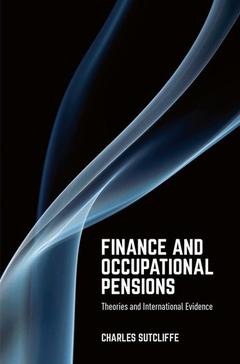Finance and Occupational Pensions, 1st ed. 2016 Theories and International Evidence
Auteur : Sutcliffe Charles

Occupational pensions are major participants in global financial markets with assets of well over $30 trillion, representing more than 40% of the assets of institutional investors. Some occupational pension funds control assets of over $400 billion, and the largest 300 occupational pension funds each have average assets of over $50 billion. The assets of UK pension funds are equivalent to UK GDP, and US pension fund assets are 83% of US GDP. These statistics highlight the importance of pension funds as major players in financial markets, and the need to understand the behaviour of these large institutional investors. Occupational pensions also play an important, but neglected, role in corporate finance. For example, US company pension schemes account for over 60% of company market value, and yet they are often ignored when analysing companies.
This book is based on the substantial body of evidence available from around the world on a topic that has become increasingly important and controversial in recent years. Written for practitioners, students and academics, this book brings together and systematizes a very large international literature from financial economists, actuaries, practitioners, professional organizations, official documents and reports. The underlying focus is the application of the principles of financial economics to occupational pensions, including the work of Nobel laureates such as Merton, Markowitz, Modigliani, Miller and Sharpe, as well as Black. This book will give readers an up-to-date understanding of occupational pensions, the economic issues they face, and some suggestions of how these issues can be tackled. The first section explains the operation of defined benefit and defined contribution pensions, along with some descriptive statistics. The second section covers selected aspects of occupational pensions. The focus of these first two sections is on the economic and financial aspects of pensions, accompanied by some basic information on how they operate. This is followed by three further sections that analyse the investment of pension funds, the corporate finance implications of firms providing pensions for their employees, and annuities.Part 1. Introduction to Pension Schemes.- 1.1 The Three Pillars.- 1.2. Replacement Rate.- 1.3. Funded versus Unfunded Schemes.- 1.4. Macroeconomic and Inter-Generational Considerations.- 1.5. Pension Scheme Membership.- 1.6. Main Types of Occupational Scheme.- 1.7. Tax Benefits of Pensions.- 1.8. Life Expectancy.- 1.9. Auto-Enrolment.- Part 2. Selected Pension Scheme Topics.- 2.1. Why Do Employers Provide Pension Schemes?.- 2.2 The Death of DB Schemes.- 2.3. The Shift from DB to DC Schemes.- 2.4. Problems with DC Schemes.- 2.5. Pensions Buy-Outs and Buy-Ins.- 2.6. Closed or Frozen Schemes.- 2.7. Dealing With Rising Longevity.- 2.8. Pension Scheme Insurance.- 2.9. The Design of Pension Schemes.- 2.10. Age and Uniform Contribution and Accrual Rates.- 2.11. Compulsory Occupational Pension Scheme Membership.- 2.12. Redistribution by Pension Schemes.- 2.13. Economies of Scale.- 2.14. Chinese Pensions.- Part 3. Investment and Pension Schemes.- 3.1. DC Schemes.- 3.2. DB Schemes.- 3.3. Other Investment Topics.- Part 4. Corporate Finance and Pension Schemes.- 4.1. Consolidation with the Company.- 4.2. Leverage Effects.- 4.3. Liquidity Effects.- 4.4. Betas and Pension Schemes.- 4.5 Other Effects.- 4.6. Irrelevance of Scheme Funding and Asset Allocation.- 4.7. Equity Investment and Risk Sharing.- 4.8. Arguments for Over and Under-funding DB Pension Schemes.- 4.9. Tax Arbitrage and DB Pension Schemes.- 4.10. Tax Arbitrage, Default Insurance and Risk Sharing.- Part 5. Annuities.- 5.1. A Simple Annuity.- 5.2. Voluntary and Compulsory Annuities.- 5.3. The Increasing Importance of Annuities.- 5.4. A Simple Annuity Pricing Model.- 5.5. Other Influences on Annuity Prices.- 5.6. Mortality Discount or Mortality Credit or Mortality Drag.- 5.7. Tontines.- 5.8. Reasons for Buying an Annuity.- 5.9. The Annuity Puzzle.- 5.10. Some Partial Explanations for the Annuity Puzzle.- 5.11. Evaluating Annuity Prices.- 5.12. Some Other Types of Annuity.- 5.13. Annuity Timing Decision.- 5.14. The Annuity Decision and the Open Market Option (OMO).- 5.15. Historical Perspective on Mortality Tables.- 5.16. Long Term Care and Adverse Selection.- 5.17. Did Joint Life Annuities Indirectly Cause the Credit Crisis?.- 5.18. Guaranteed Annuity Rates (GAR).- 5.19. Deferred Annuities.- 5.20. A Long Term Solution? Single Premium Deferred Annuities (SPDA).-
Charles Sutcliffe is a professor of finance at the ICMA Centre, Henley Business School, University of Reading, where he teaches a course on occupational pensions. Between 2001 and 2007 he was a member nominated trustee of the Universities Superannuation Scheme (USS), and from 1981 to 1985 a trustee of the Berkshire Local Authorities Superannuation Fund.
Date de parution : 12-2016
Ouvrage de 317 p.
15.5x23.5 cm
Disponible chez l'éditeur (délai d'approvisionnement : 15 jours).
Prix indicatif 52,74 €
Ajouter au panier


